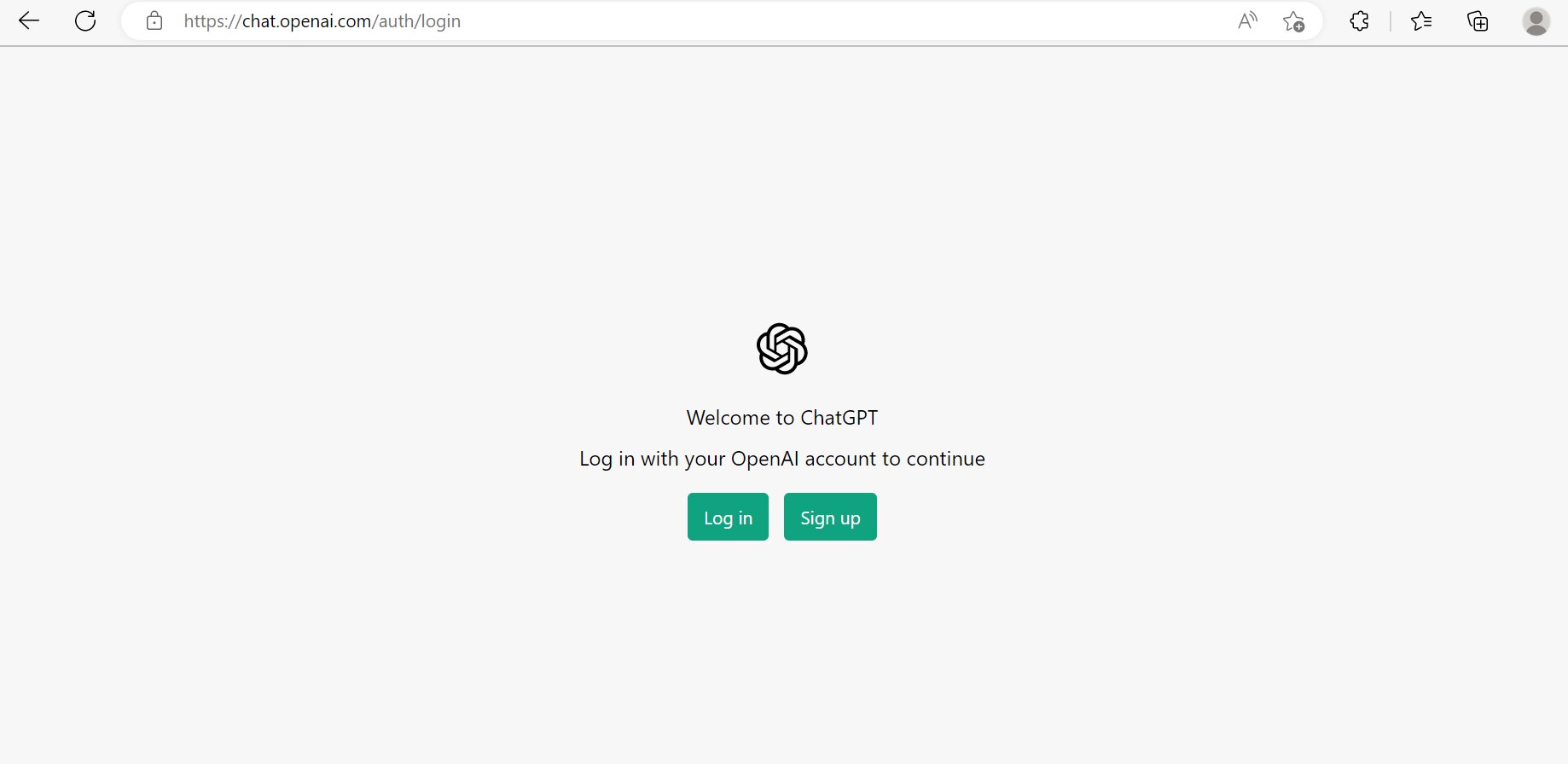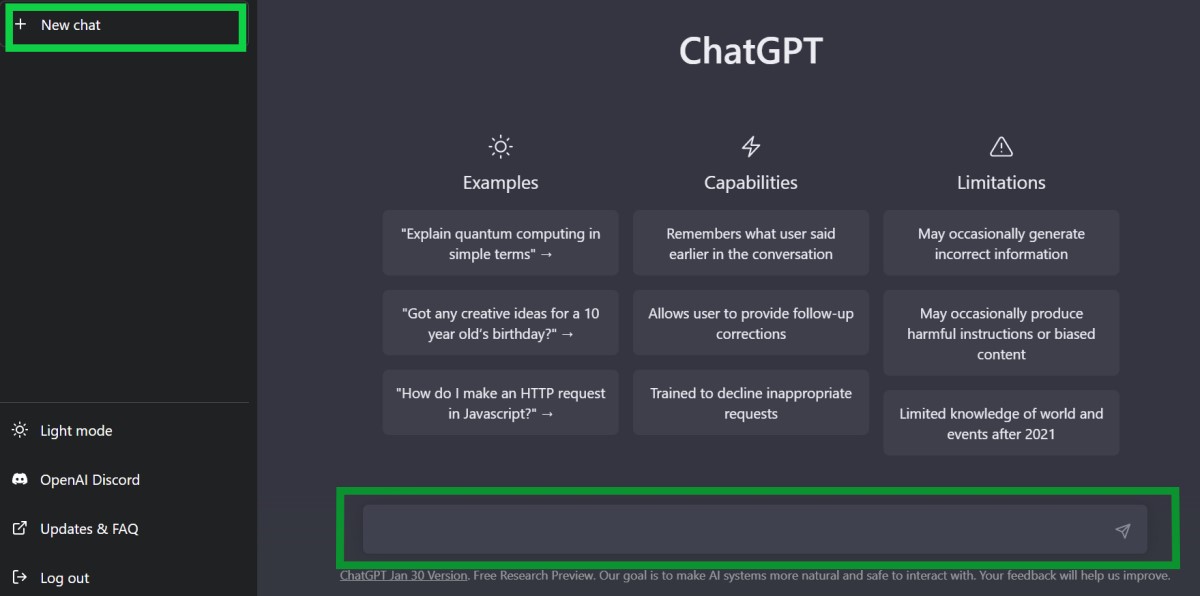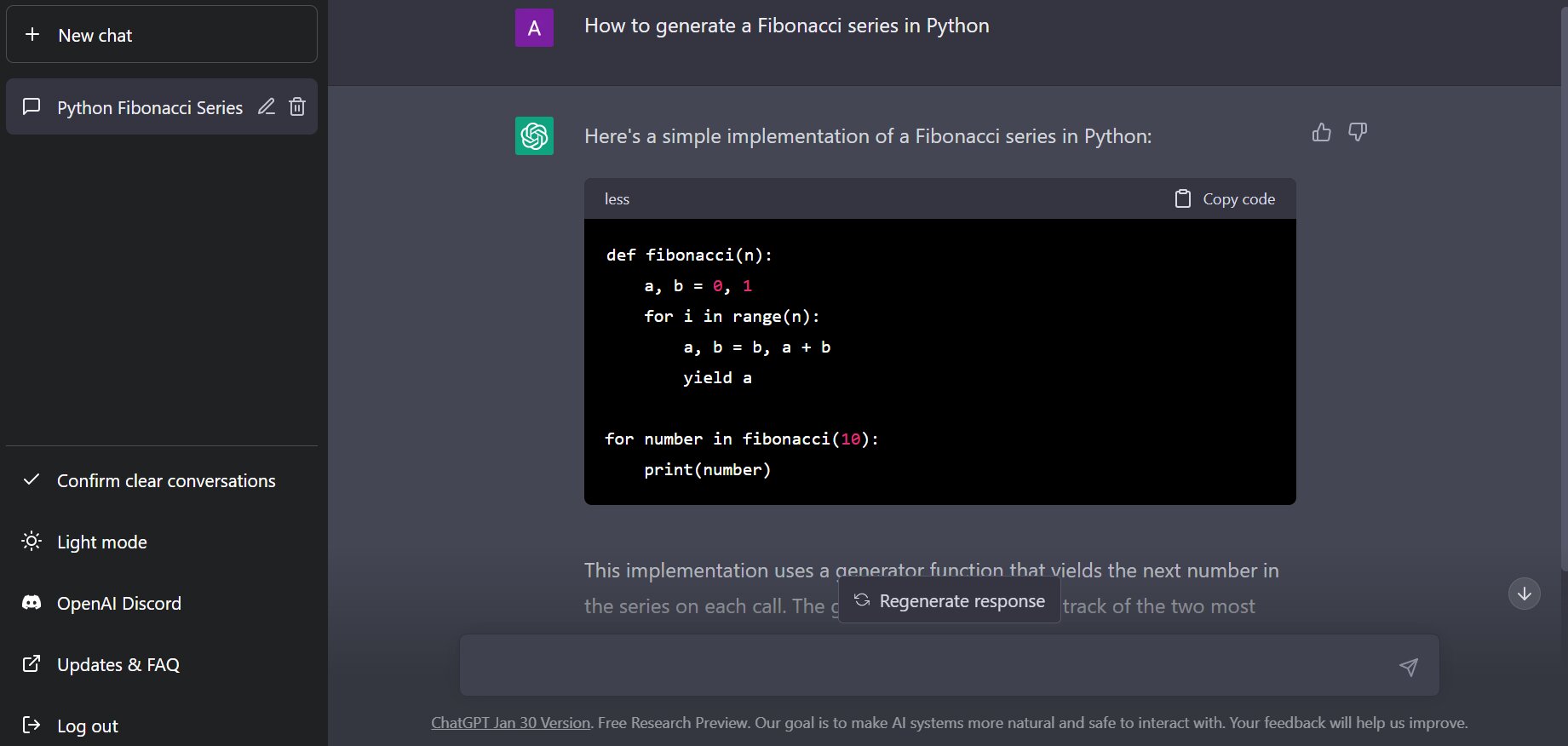How to use ChatGPT?
Discover the power of ChatGPT, the cutting-edge language model. This language model is taking the world by storm with its human-like text generation & vast knowledge base.
“Why settle for a plain old chatbot when you can have a GPT-powered one? It’s like upgrading from a tricycle to a Tesla.”
What is ChatGPT?
ChatGPT is a computer program designed to hold conversations with humans in a natural and engaging way. It uses artificial intelligence and machine learning techniques to understand and respond to text-based input. This allows it to have conversations that are more like those between two humans. This makes it a powerful tool for industries such as customer service, marketing, and content creation. In simple terms, ChatGPT is like a virtual assistant that can hold a conversation with you and answer your questions, just like a human would.

- ChatGPT is a language generation model by OpenAI
- Generates human-like text through deep learning techniques
- Can hold natural conversations with users
- Impacts industries such as customer service, marketing, and content creation
- Build conversational interfaces, generate content, and power virtual assistants with it.
Best-suited ChatGPT courses for you
Learn ChatGPT with these high-rated online courses
How to Use ChatGPT?
The user interface of the ChatGPT is so simple that trying it makes a piece of cake for anyone.
You can start using ChatGPT from OpenAI’s official website: https://chat.openai.com/. Here are the steps you can follow:
Step 1: Signup and Login to the ChatGPT platform. You can signup using an existing email id. It will ask your mobile number for verification. Once its verified you are ready to go.
Step 2: Once you login you will see a new chat window which gives you the examples, capabilities and limitation of chatGPT. You can start writing your prompt here.
Step 3: Just ask what you want to know and ChatGPT will come up with smart responses for your reference.
You can even integrate ChatGPT with various platforms and use in a variety of ways, including:
- OpenAI API: OpenAI provides access to ChatGPT and other models through its API. You can sign up for an API key and start using ChatGPT by sending text inputs to the API and receiving responses.
- Pre-trained Models: OpenAI also provides pre-trained models that you can download and use. You can fine tune these models for specific use cases or integrate into other systems.
- Messaging Integration: Revolutionize customer service by integrating ChatGPT into messaging platforms such as Slack or Microsoft Teams, effortlessly providing customers with a convenient way to access information and support.
- Standalone Application: Users can interact with ChatGPT directly through a user interface or command line interface as a standalone application.
To use ChatGPT, you will need to have access to the pre-trained model provided by OpenAI. Once you have access to the model, you can use it as it or fine-tuning the model for a specific use case and integrate it into your platform or application.
Things you might want to try with ChatGPT
- Questions: Ask ChatGPT anything you want to know, such as “What is the capital of France?” or “How do I make a cake?”
- Conversations: Have a conversation with ChatGPT on any topic, such as “What do you think about climate change?” or “Do you like traveling?”
- Summarize Text: Provide a long piece of text and ask ChatGPT to summarize it for you.
- Translation: Provide a sentence in one language and ask ChatGPT to translate it to another language.
- Generate Text: Ask ChatGPT to generate text based on a prompt, such as “Generate a story about a magic kingdom.”
- Poetry generation: Generate a poem on a specific topic or emotion.
- Storytelling: Provide a plot and characters, and ask ChatGPT to create a short story.
- Song lyrics generation: Generate song lyrics on a specific theme or emotion.
- Character creation: Create a character with specific personality traits and a backstory.
- Jokes: Generate a joke in a specific category, such as puns or one-liners.
Read More:
Best Practices for using ChatGPT
Here are some best practices for using ChatGPT:
- Be clear and specific: When asking ChatGPT a question or providing a prompt, make sure to be as clear and specific as possible. This will help ChatGPT better understand what you’re looking for and generate more accurate and relevant responses.
- Provide context: When asking a question or providing a prompt, try to provide as much context as possible. This will help ChatGPT better understand the situation and generate more appropriate responses.
- Give positive feedback: If you like a response generated by ChatGPT, let it know! Providing positive feedback will help the model learn and improve over time.
- Use proper grammar and spelling: Using proper grammar and spelling when communicating with ChatGPT will make it easier for the model to understand and respond to your inputs.
- Be aware of limitations: While ChatGPT is a very advanced language model, it still has limitations. It’s important to understand what the model is capable of and what it’s not, and to use it appropriately.
More Interesting Questions you can ask
Following are some questions which might be interesting for my readers who believe in technology. Share your views or chat and dig dive with ChatGPT.
- List out 5 most incredible scientific discovery yet to be made
- Can machines ever truly understand human emotions?
- What could happen if we are actually living in a matrix?
- What happens if our reality is actually a simulation?
- What are the dark secret theory behind black holes?
- What are the possibilities if we could transfer human consciousness to an AI?
- What if humans are actually AI, developed by more advance being whom we started referring as creator or GOD?
- What if temples depict the spaceship in which advance being visit our planet who helped us and now we refer them as GOD?
- Can AI replicate itself like human?
- What would happen if time travel were possible?
- Can you discuss the existence of parallel universes and alternate realities?
- What is the greatest mystery of the universe that scientists have yet to solve?
- What is the impact of climate change on the world?
- What are the most pressing ethical concerns in AI and automation?
- Can you explain the concept of quantum mechanics?
- What are the most important steps for solving world hunger?
- What is the most important issue facing society today?
- Can you discuss the pros and cons of genetically modified foods?
- What are the potential consequences of a world without privacy?
- Can you predict the future of renewable energy?
- What are the most important technological innovations to look out for in the next decade?
- What is the impact of AI on society and the economy?
- Can you discuss the future of space exploration and colonization?
- What are the most pressing global security threats in the next 50 years?
- What is the future of education and learning?
How Different Industries can use ChatGPT?
| Industry | Current Problem | How Can ChatGPT Fix the Problem? | Example |
|---|---|---|---|
| Retail | Poor customer shopping experience, high workload for customer service representatives | ChatGPT can provide instant, personalized assistance to customers with product information, size recommendations, and order tracking, reducing the workload for customer service representatives | “I’m looking for a red dress in size medium. Can you help me find it?” |
| Healthcare | Limited access to healthcare information and services, high workload for medical staff | ChatGPT can triage patients based on their symptoms, provide information on health conditions, and direct patients to the appropriate care setting, improving access to healthcare and reducing workload for medical staff | “I have a fever and a cough, what should I do?” |
| Financial Services | Slow and inefficient customer support, limited access to financial information | ChatGPT can provide instant assistance to customers with account information, answer financial questions, and assist with online transactions, streamlining customer support and improving access to financial information | “Can you help me check my account balance?” |
| Education | Limited access to information and support for students, high workload for administrative staff | ChatGPT can answer student questions, provide information on courses and enrollment, and assist with student support services, improving access to information and support for students and reducing workload for administrative staff | “I’m thinking about studying computer science, what classes do I need to take to get started?” |
| Technology | Slow and inefficient technical support, poor customer satisfaction | ChatGPT can provide quick and efficient technical support and assist with product-related questions and troubleshooting, improving customer satisfaction and reducing workload for support staff | “I’m having trouble logging into my account, can you help me fix it?” |
What makes ChatGPT unique compared to other language models?
- Advanced Natural Language Processing (NLP) capabilities: ChatGPT’s transformer-based architecture allows it to understand and generate human-like language, making it highly effective for a variety of use cases.
- High Accuracy: Fine-tuning for specific use cases, such as customer service or technical support, results in high accuracy and relevance for specific types of questions.
- Multi-Turn Conversation Support: Ability to handle multiple rounds of conversation allows for more natural and interactive experiences compared to other language models.
- Customization: It can be tailored to specific domains or industries, providing industry-specific information and answers.
- Seamless Integration: Can be integrated into websites, mobile apps, and messaging platforms, providing customers with a convenient way to access information and support.
What are the Limitations of ChatGPT?
Some of the limitations of ChatGPT include:
- Bias: ChatGPT, like other language models, can exhibit bias based on the data it was trained on. This can lead to problematic or offensive output in certain situations.
- Lack of Context: Can only understand the context of a conversation to the extent that it was trained on. This can lead to misunderstandings or nonsensical responses in certain situations.
- Limited Creativity: While ChatGPT can generate text that appears creative or imaginative, it is ultimately limited by the data it was trained on and the algorithms used to generate text.
- Lack of Common Sense: It lacks a true understanding of the world and human behavior and relies on patterns it has seen in its training data. This can lead to limitations in its ability to understand and respond to complex or abstract questions.
- Safety Concerns: The potential applications of language models like ChatGPT, including the generation of fake news or deepfakes, have raised concerns about their potential misuse.
NOTE: ChatGPT and other language models are still in the early stages of development and that these limitations may be addressed as the technology evolves.
FAQs
Who built ChatGPT?
ChatGPT was created by OpenAI. It is a leading research organization focused on artificial intelligence. It was founded in 2015 by Elon Musk, Sam Altman, Greg Brockman, Ilya Sutskever, Wojciech Zaremba, and John Schulman with the aim of promoting and developing friendly AI that benefits humanity. OpenAI has been at the forefront of AI research and development, with a focus on NLP and language models.
How does ChatGPT work?
ChatGPT is based on the transformer architecture and uses a deep neural network to generate text. It is trained on a large corpus of text data and can generate responses based on the context and input it receives.
Is ChatGPT capable of understanding context and context-based reasoning?
Yes, ChatGPT has been trained on a large corpus of text data and can understand context to some extent. It can generate responses based on the context and input it receives.
Can ChatGPT pass the Turing test?
The Turing test is a measure of a machine's ability to exhibit human-like behavior and intelligence, and ChatGPT has not been designed specifically to pass this test. However, it can generate responses that may seem human-like to some extent.
Is ChatGPT a threat to human jobs?
While ChatGPT and other AI models can automate certain tasks that were previously performed by humans, it is unlikely to completely replace human workers in most industries. Instead, it may augment human capabilities and create new job opportunities.
Is ChatGPT a Reliable Technology?
ChatGPT is a highly advanced AI technology that has been trained on a large amount of data and is capable of generating human-like text based on patterns it has learned. However, as with any technology, it is important to critically evaluate the outputs of ChatGPT and understand its limitations. ChatGPT is only as reliable as the data it was trained on, and its outputs can be biased or inaccurate if the training data reflects these issues. Additionally, ChatGPT is a statistical model and its outputs are probabilistic, meaning that they are not always correct. In certain applications, ChatGPT can be a highly effective and reliable technology, but in others, it may not be appropriate or suitable. It is important to understand the specific capabilities and limitations of ChatGPT and carefully evaluate its suitability for a given use case.
Can ChatGPT write algorithms and generate code for it?
Yes, ChatGPT can generate code and write algorithms, however, the quality and reliability of the code it generates may vary. ChatGPT has been trained on a large amount of data that includes code and algorithms, and it is capable of generating code snippets based on patterns it has learned. However, it is important to understand that ChatGPT is not a full-fledged software development tool and its outputs may need to be reviewed and corrected by human developers. Additionally, ChatGPT's outputs are based on statistical models and are probabilistic, meaning that they are not always correct. As a result, the code generated by ChatGPT may contain errors or inefficiencies that need to be corrected by human developers.
Who was chatGPT created for?
ChatGPT was created for a wide range of users, including researchers, developers, and organizations in various industries that are interested in using AI for natural language processing tasks, such as content creation, chatbots, language translation, and sentiment analysis. In general, ChatGPT was designed to help users generate high-quality text outputs quickly and efficiently, with applications in areas such as journalism, marketing, education, and customer service. By providing a highly advanced AI model that can generate human-like text, ChatGPT has the potential to augment the capabilities of users and help them achieve their goals more effectively.

Experienced AI and Machine Learning content creator with a passion for using data to solve real-world challenges. I specialize in Python, SQL, NLP, and Data Visualization. My goal is to make data science engaging an... Read Full Bio




